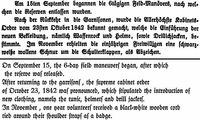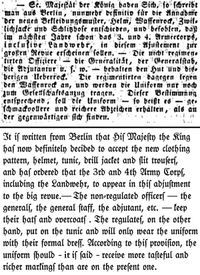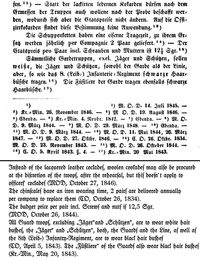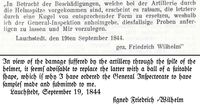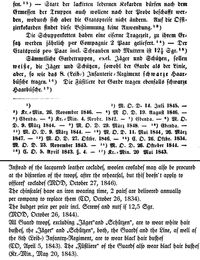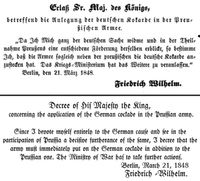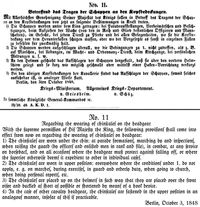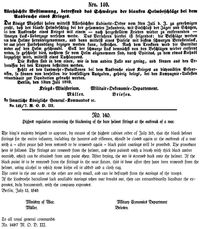23.10.1842:
Introduction of the spiked leather helmet for the foot troops (except for the „Jäger“). The helmet had the following features:
- Leather helmet with a height of about 34 to 38 cm. Metal metal fittings made of brass or nickel silver. For the Guards, the fittings were made of tomback. The complete helmet M42 weighed 900 to 1000 g.
- The complete fitting on its top was about 13 to 14 cm high. The spike could be replaced by a hair plume funnel for the special units. The spike of the officers had a ribbed wreath at the lower end. The neck of the fitting was decorated with a pearl ring, which was more elaborately designed by the officers. The spike base was a cross fitting (called „Kleeblatt“ (cloverleaf) in Germany), which was held on the leather shell by 4 half round head threaded pins (4 star head threaded pins for officers). From the inside, squared bow nuts were used to fix the fitting and helmet eagle onto the shell.
- Frontside, it had a large angular front visor of leather, which was reinforced all around with a metal visor trim.
- Above the front visor was a 12,5 to 13 cm high heraldic eagle of metal, with a "FR" on its chest. This stood for "Friedericus Rex" and was worn in honor of the soldier-king Frederick-Wilhelm I. (with the exception of the old regiments 1-12, which wore an oval shield with the royal inscription "FWR" on the chest). Guard regiments wore a flying eagle with a guard star on the chest.
- Backside was a long neck cover, also of leather.
- In the middle of the Helmet's back side, a vertically running rear spine was attached with 2 threaded pins. For enlisted men's helmets the fasteners were visible from the outside, for officers' helmets the rear spine was usually smooth from the outside and the threaded pins were soldered on from on the inside of the helmet spine.
- On the side of each was a curved chin scale, which was attached with a rosette and a set of screw with elongated decorative nut. The decorative nut was turned and decorated a little more complex for the officers. A leather cockade with a diameter of 70 to 75 mm was worn on the right side under the chinscale. For enlisted men it was a painted black disk with a white ring, officers had a silver ring.
22.2.1843:
Introduction of the metal pickelhaube for the cuirassiers:
- Because the regiment was special, the helmet was tested extensively before it was introduced, which is why it took place later.
05.04.1843:
Introduction of hair plumes for Guards and „Leib“-Regiments:
- White hair plumes: For all Guard regiments (except „Jäger“ and „Schützen“) and Grenadier regiments 1 to 12.
- Black hair plumes: For hunters and riflemen (for Guard and Line regiments), fusiliers and the 8th Infantry Leib Regiment.
- Red hair plumes: For musicians
- The pin of the hair plume funnels, used to attach the hair to the funnel, had a turned button for officers. This was painted black for NCOs with white hair, white for black and red hair, and was otherwise the color of the fittings.
- The hair plume was made of horse hair, for officers (according to clothing regulations) of buffalo hair since 1896.
09.03.1844:
Portepee NCOs and music masters received permission to wear the officer's cockade.
19.09.1844:
Introduction of the ball (instead of the spike) for artillery, because of the injuries that occurred when the canons were reloaded.
27.10.1846:
Introduction of the woolen cockade with a diameter of 75 mm for enlisted men, as the paint on the original leather cockade did not hold well. The regulation wasn’t valid for Officers, but they often wore silk cockades in silver-black at that time.
21.03.1848 to 14.03.1851:
(AKO was signed by the King on 03/14/1851, but the announcement was made on 03/18/1851):
At this time, the German cockade made of fabric in black, red and gold (counted from the inside) was worn on the left.
03.10.1848:
With AKO of October 3, 1848, the closure of the raised chin scales was permitted by means of a "hooking device". Initially, the locking device on the last scales of the chin scales (lh: knob (hook) / rh: eyelet) was thus only an option. In issue 175 (3/1961) of the "Zeitschrift für Heereskunde" it is further mentioned that these closures were introduced with the replacement deliveries, but unfortunately it is not mentioned when these replacement deliveries took place.
Sometime between October 1848 and 1856, however, this locking device was then introduced as mandatory. Unfortunately, I could not find the exact date or year, so I would be extremely grateful for the sending of an original source in this regard (My eMail: see imprint).
03.07.1849:
In the course of the campaign against Schleswig-Holstein, the military complained that the shiny fittings would give away their positions in battle. Therefore it was determined that the fittings of the headgear should be blackened with amber varnish in case of war.
26.06.1856:
Introduction of the flat chin scales for enlisted men of foot troops (without artillery), as the curved ones made it difficult to aim the rifle.
- As a result, the rosette also had to be adjusted. The long, ornate, set screws were replaced by round head screws, which were now screwed up to the rosettes.
